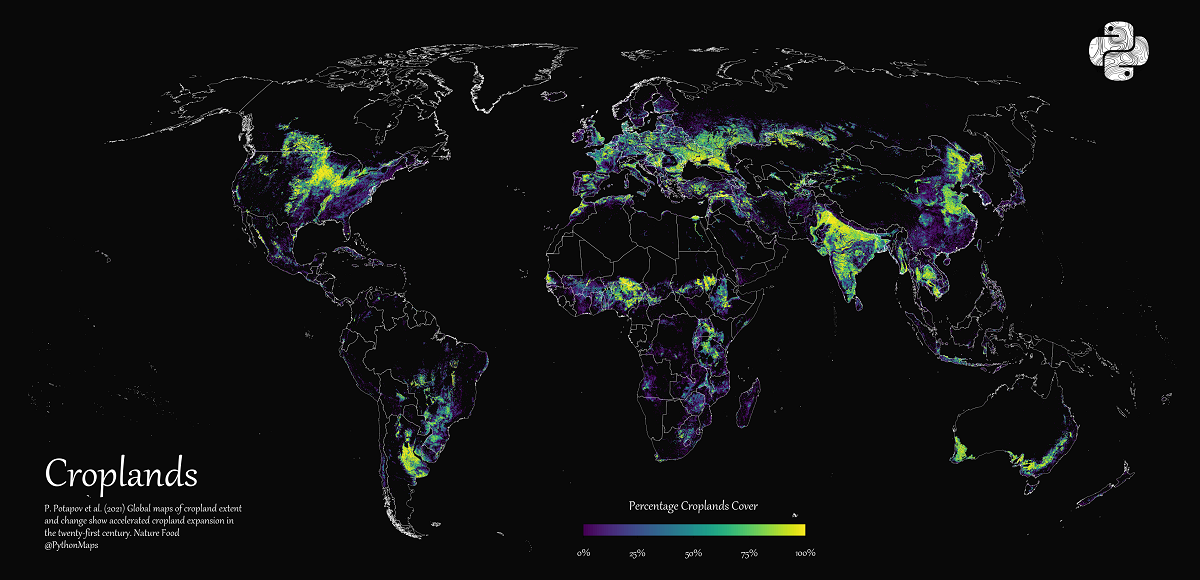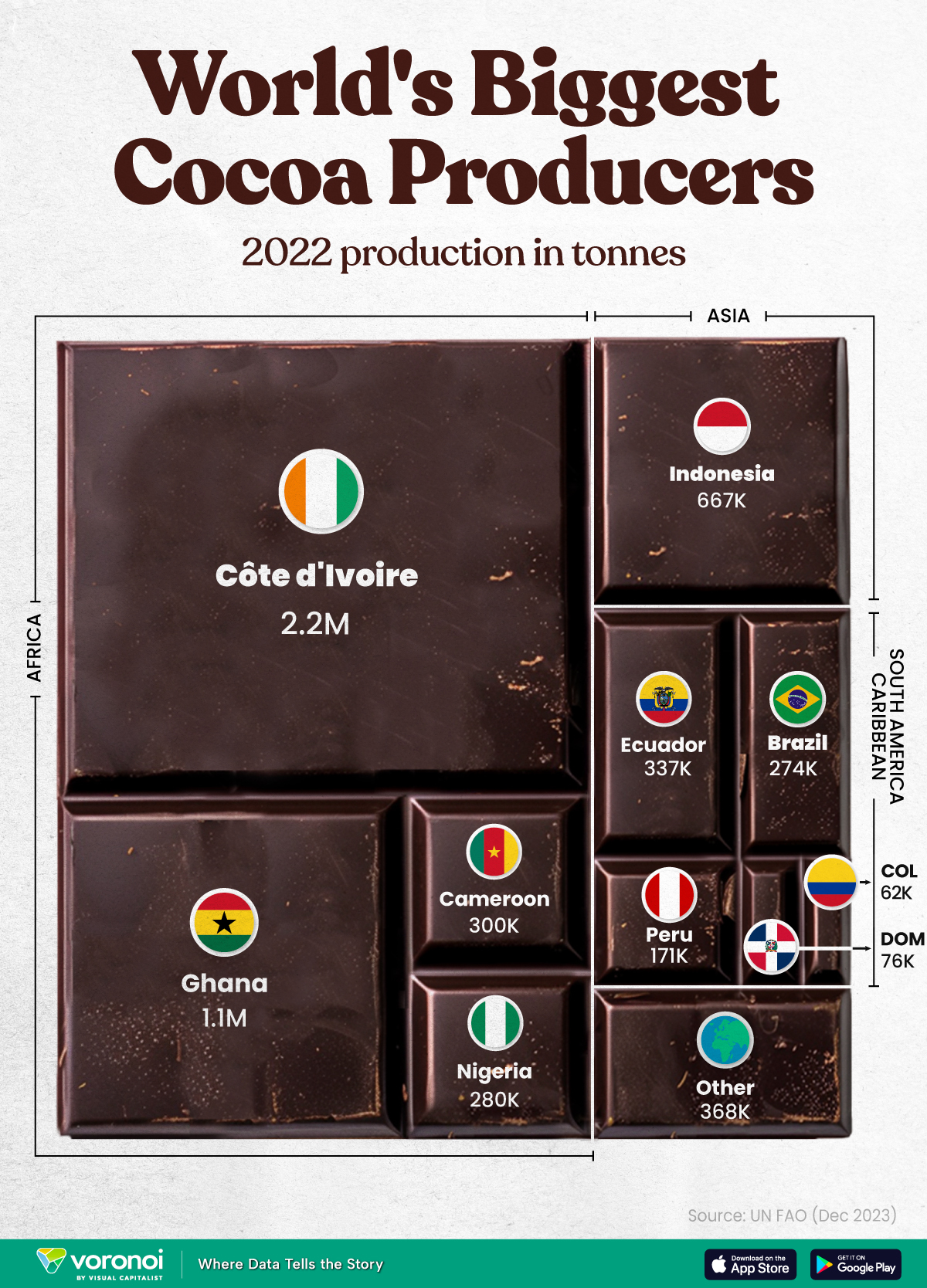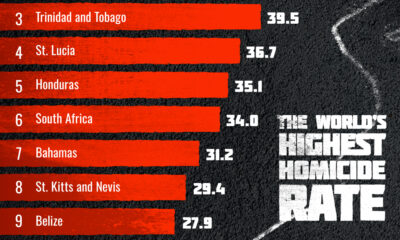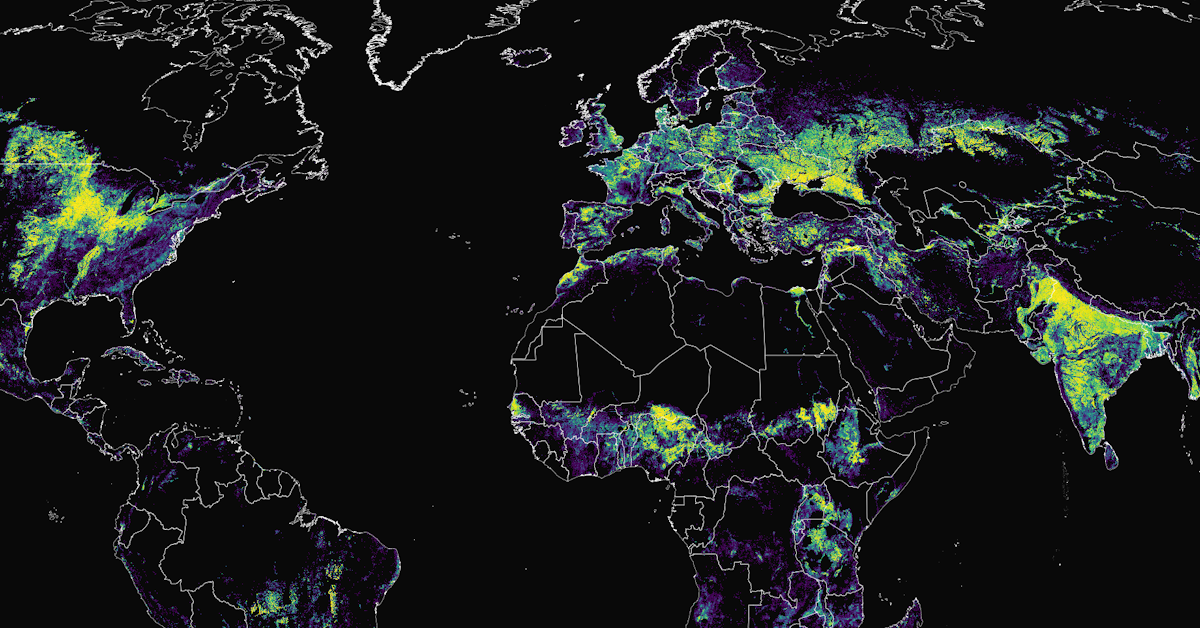Agriculture
The World’s Top Cocoa Producing Countries
![]() See this visualization first on the Voronoi app.
See this visualization first on the Voronoi app.
The World’s Top Cocoa Producing Countries
This was originally posted on our Voronoi app. Download the app for free on iOS or Android and discover incredible data-driven charts from a variety of trusted sources.
West Africa is home to the largest cocoa producing countries worldwide, with 3.9 million tonnes of production in 2022.
In fact, there are about one million farmers in Côte d’Ivoire supplying cocoa to key customers such as Nestlé, Mars, and Hershey. But the massive influence of this industry has led to significant forest loss to plant cocoa trees.
This graphic shows the leading producers of cocoa, based on data from the UN FAO.
Global Hotspots for Cocoa Production
Below, we break down the top cocoa producing countries as of 2022:
| Country | 2022 Production, Tonnes |
|---|---|
| 🇨🇮 Côte d'Ivoire | 2.2M |
| 🇬🇭 Ghana | 1.1M |
| 🇮🇩 Indonesia | 667K |
| 🇪🇨 Ecuador | 337K |
| 🇨🇲 Cameroon | 300K |
| 🇳🇬 Nigeria | 280K |
| 🇧🇷 Brazil | 274K |
| 🇵🇪 Peru | 171K |
| 🇩🇴 Dominican Republic | 76K |
| 🌍 Other | 386K |
With 2.2 million tonnes of cocoa in 2022, Côte d’Ivoire is the world’s largest producer, accounting for a third of the global total.
For many reasons, the cocoa trade in Côte d’Ivoire and Western Africa has been controversial. Often, farmers make about 5% of the retail price of a chocolate bar, and earn $1.20 each day. Adding to this, roughly a third of cocoa farms operate on forests that are meant to be protected.
As the third largest producer, Indonesia produced 667,000 tonnes of cocoa with the U.S., Malaysia, and Singapore as major importers. Overall, small-scale farmers produce 95% of cocoa in the country, but face several challenges such as low pay and unwanted impacts from climate change. Alongside aging trees in the country, these setbacks have led productivity to decline.
In South America, major producers include Ecuador and Brazil. In the early 1900s, Ecuador was the world’s largest cocoa producing country, however shifts in the global marketplace and crop disease led its position to fall. Today, the country is most known for its high-grade single-origin chocolate, with farms seen across the Amazon rainforest.
Altogether, global cocoa production reached 6.5 million tonnes, supported by strong demand. On average, the market has grown 3% annually over the last several decades.
Environment
Mapped: How Much of the World is Covered by Croplands?
Where are the world’s croplands located? This detailed map highlights the world’s cropland cover as of 2019.

Mapping Cropland Cover Around the World
Over the last 50 years, the world’s human population worldwide has grown exponentially.
And this population explosion brought greater food production needs with it, through livestock breeding, cropland expansion, and other increases in land use.
But how evenly is this land distributed globally? In this graphic, Adam Symington maps global croplands as of 2019, based on a 2021 scientific paper published in Nature by Peter Potapov et al.
The World’s Croplands
Croplands are defined as land areas used to cultivate herbaceous crops for human consumption, forage, and biofuel. At the start of the 21st century, the world’s croplands spread across 1,142 million hectares (Mha) of land.
Some of these croplands have since been abandoned, lost in natural disasters, or repurposed for housing, irrigation, and other infrastructural needs.
Despite this, the creation of new croplands increased overall cropland cover by around 9% and the net primary (crop) production by 25%.
Africa and South America Lead Croplands Expansion
In 2019, croplands occupied 1,244 Mha of land worldwide, with the largest regions being Europe and North Asia and Southwest Asia at around 20% of total cover each.
Interestingly, even though Africa (17%) and South America (9%) held lower percentages of the world’s croplands, they saw the highest expansion in croplands since 2000:
| Region | Cropland Area (Mha, 2000–03) | Cropland Area (Mha, 2016–19) | Change (Mha) |
|---|---|---|---|
| Africa | 155.1 | 208.3 | +53.2 |
| South America | 75.5 | 112.6 | +37.1 |
| Southwest Asia | 237.3 | 244.8 | +7.5 |
| Australia and New Zealand | 37.3 | 40.3 | +3.0 |
| North and Central America | 192.1 | 193.9 | +1.8 |
| Europe and North Asia | 252.3 | 253.2 | +0.9 |
| Southeast Asia | 192.7 | 191.1 | -1.6 |
| World | 1,142.3 | 1,244.2 | +101.9 |
South American nations including Argentina, Brazil, and Uruguay witnessed a steep rise in crop production between 2000 and 2007. Agricultural growth in the region can be attributed to both modern agricultural technology adoption and the production of globally demanded crops like soybeans.
A similar expansion in croplands within Sub-Saharan African countries at the start of the 21st century continues to persist today, as producers ramp up crop production for both exports and to try and alleviate food scarcity.
Much of these the world’s croplands were once forests, drylands, plains, and lowlands. And this loss in green cover is clearly seen across Africa, South America, and parts of Asia.
However, some regions have also witnessed tree plantations, orchards, and aquaculture replacing former croplands. One such example is Vietnam’s Mekong Delta, and indeed Southeast Asia was the only region that saw an overall decline in cropland cover from 2000 to 2019.
Moving Towards Sustainable Agriculture
The expansion of croplands has also come at a cost, destroying large stretches of forest cover, and further contributing to wildlife fragmentation and greenhouse gas emissions.
However, hope for more sustainable development is not lost. Nations are finding ways to improve agricultural productivity in ways that free up land.
As global demand for food continues to increase, agricultural expansion and intensification seem imminent. But innovation, and a changing climate, may elevate alternative solutions in the future.
-

 Misc1 week ago
Misc1 week agoHow Hard Is It to Get Into an Ivy League School?
-

 Technology2 weeks ago
Technology2 weeks agoRanked: Semiconductor Companies by Industry Revenue Share
-

 Markets2 weeks ago
Markets2 weeks agoRanked: The World’s Top Flight Routes, by Revenue
-

 Countries2 weeks ago
Countries2 weeks agoPopulation Projections: The World’s 6 Largest Countries in 2075
-

 Markets2 weeks ago
Markets2 weeks agoThe Top 10 States by Real GDP Growth in 2023
-

 Demographics2 weeks ago
Demographics2 weeks agoThe Smallest Gender Wage Gaps in OECD Countries
-

 United States2 weeks ago
United States2 weeks agoWhere U.S. Inflation Hit the Hardest in March 2024
-

 Environment2 weeks ago
Environment2 weeks agoTop Countries By Forest Growth Since 2001












 Creator Program
Creator Program
